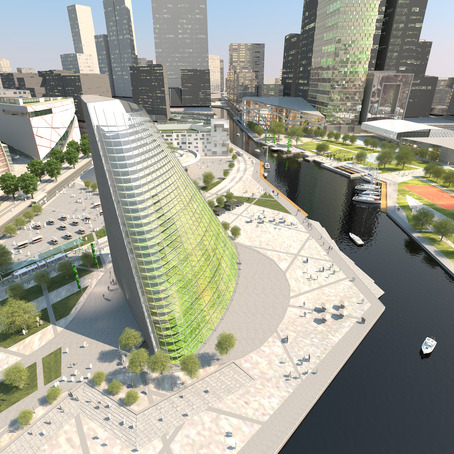The Future of Urban Agriculture (and other insights)
Last weekend Jed and I went back to the Guggenheim Lab in Prenzlauer Berg for a roundtable discussion on urban agriculture. This is a particular interest for both of us and we really looked forward to seeing another Canadian at the discussion: Taymoore Balbaa, instructor from Ryerson University and partner at Atelier3am, who was one of the key presenters and organizers.
We got there just at the tail end of Taymoore's presentation, but were able to see the next 2 presentations.
Jana Milosovicova from Berlin gave a short overview of some of the main points of urban agriculture:
- "Sustainable Urbanism" means using existing space efficiently to create productive land.
- Instead of creating parks, we should be creating productive lands.
- Multi-story dwellings rather than sprawl
- Using gaps between buildings, roofs, and brownfield sites that might otherwise never get used
- Entrusting undefined spaces to local residents
She showed this proposal by Perkins + Will for the city center airport decommissioning in Edmonton (which made me right proud!) and talked about the Vancouver Greenest City 2020 plan.
Some of the points she mentioned I was like 'meh' or critical about, like:
> Reducing ceiling heights in apartments to get more apartments in the same size building - I am all for people getting used to less personal space (100m2 / 1000 square feet is plenty of space for a family of 4), but if people are going to get used to this it has to be high quality living space. That means high quality materials, lots of light, and at minimum, 2.8-3m ceilings. We have 4m ceilings and this lets us have huge windows, and I'm telling you that in a bedroom the size of a shoebox it makes all the difference.
> Flat roofs are more efficient in terms of space - Yeah... maybe... but in terms of shedding rain and snow, they suck. Roofs should definitely incorporate extensive plantings, but I wouldn't go so far to say that all buildings should be required to have flat roofs. Hello boring modernist cities..
> Productive potential within vertical spaces: i.e. Vertical Farm in Linköbing, Sweden
Do you enjoy hanging out in an empty parking lot? If so, this project might be for you.
In theory I agree with the idea, but in practice I'm critical of whether vertical farms are actually viable or just there to pretty up the renderings and put a touch of 'sustainable' to a project. Practical questions: who is responsible for caring for the farm? How do they access the building? Is the farm publicly accessible? What is the infrastructure for accessing all parts of the farm? Will plants be planted normally or sideways? How to maintain a balanced humidity factor and prevent condensation on the inside of the building?
Also, just look at this image. Why the hell would you concentrate the productive space vertically inside a building and then pave 90% of the surroundings? This makes me angry!! I hate boundlessly paved "public spaces." At the very least, make it permeable pavings or a combination of wild grasses and trees. *stabs paving*
Yes... well. All in all, some good points--nothing terribly groundbreaking--but good to keep in mind.
Next, Marco Schmidt from the TU Berlin, gave a presentation called "Watergy"
The main point of this presentation was that there is a huge amount of energy embodied in the phase changes of water, about 10 times more than other elements. When you can reduce the amount of heat energy that is reflected from hard surfaces in cities by planting anything green to absorb the heat and transfer the energy into evaporation, you will reduce the heat island and desertification effect enormously.
Example from the past: Giza used to be a blossoming city of green. The Egyptians deforested the area to build boats and now, 2000 years later, it is a desert. If you dig down, there are lots of underground rivers and streams, but nothing is left to contribute to the water cycle. The point is:
If you don't evaporate water, you don't get precipitation, and that leads to desertification.
For every m2 of lost evaporation (i.e., heat reflected by hard surfaces instead of absorbed and converted by water), we lose 3 cubic meters of precipitation. The answer to this is ridiculously simple. Put anything GREEN on top of anything NOT GREEN. Plant trees. Anything that requires water to grow will give back water to the atmosphere.
Here's where it got a bit "huh?" for me.
Global warming is related to the loss of vegetation, not CO2 emissions.
Marco showed a graphic that compared the total output of CO2 emissions from human related sources to CO2 emissions from vegetation. Because as we all know and remember from high school, photosynthesis is an annual cycle that acts as a lung for the whole earth. From Jan-June the earth breathes in (takes in CO2 for the growth cycle) and from July to Dec it breathes out (emits CO2)
You may remember this from 'An Inconvenient Truth'
He showed this chart, but said the one thing about Al Gore's presentation that drives him crazy is that Gore stated that the planet is undergoing global warming and climate change because of this human-activity based increase of CO2 in the atmosphere. According to Marco, this is false. While it is true there is more CO2 in the atmosphere, the reason is because we are cutting down trees and getting rid of green spaces. When there are less forests and green areas to turn heat radiation into water, we are reflecting more heat into the atmosphere and that is also part of what is causing global warming...
This graphic shows the comparative scale of the resources available, the resources consumed, and the total solar radiation from the sun each year.
The blue box represents the amount of solar heat that is converted into water by plants. The less plants there are to evaporate water, the more heat we will still have within our atmosphere from the sun. Marco says this is what is causing global warming, rather than the output of CO2.
Marco Schmidt is all for sustainable land use, roof greening, and harnessing evapo-transpiration as a cooling method for buildings. As far as the argument about global warming and CO2 emissions, it makes sense both ways for me. It doesn't take a science genius to understand the basics of cooling through evaporation (e.g., sweating on a hot day). It makes sense to me that we can seriously reduce the effects of global climate change through intensive and extensive plantings, reforestation strategies, and having more urban farms.
So here is where I get annoyed with architects and landscape architects.
I would say in 90% of the projects we get, we cut down trees. We cut down trees because they block the view. We cut down trees because they bring too much shading to the sunny side of the street. We cut down trees because they don't match the tree species we want to plant nearby. Every time I see an x through a tree on a site plan, I want to choke someone. Unless a tree is dead, there is no reason to cut it down.
I would say that most people on earth would like to have more trees in their cities. It is not the general population you have to convince... it is people like this:
It's back... and it still makes me angry.
It is designers like this who believe that they are providing a slick open space when in fact they are contributing to urban runoff and the heat island effect with their modernist 'open space planning'. They agonize where to put a single clump of trees. It is not that difficult, people!
So.
The presentations really went off in different directions, so I can't give you a good summary of what the future of urban agriculture is. All I know is that there has to be support from 2 directions: top down legislation that provides an incentive for growing your own food (and greening your roof) and a bottom up desire for fresh, local produce rather than pineapples in December.
Oh, and STOP CUTTING DOWN TREES.

















